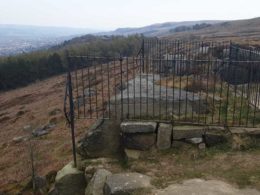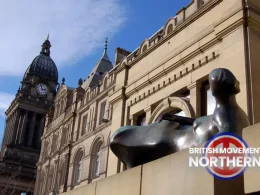- Note: The county of Cheshire forms the southern boundary of the British Movement Northern region, and it is fitting that the county town, the city of Chester is included in this series.
Prior to the Roman occupation of Britain, there seems to be little evidence of a settlement at this location on the banks of the River Dee. The area was a frequently contested territory between the Celtic tribes of this region seeking control of the Cheshire Plain.
Deva Victrix
Early on in the Roman invasion and conquest of Britannia, the Roman governor Frontius began the construction of a substantial fortress on the banks of the River Dee (possibly known to the Britons at the River Deva). Construction began around the year 75 AD and was operational by 79 AD, it was a substantial fortress and was the base for a full Roman legion, principally to control river traffic along the Dee, with docks for cargo, and as a military base to help contain the Celtic tribes in Wales.
The original timber walls of the fortress were replaced by stone walls across the Roman period and Deva became a city to rival London and York in importance. The Roman Road network passed through Chester, connecting major towns and cities. After the collapse of the Roman Empire, Chester declined as a town but continued to be a route into Wales and a route into the North of England.
The Battle of Chester – 613-616 AD
There are different dates for this battle during the early Anglo-Saxon period, but the Chronicles record that Aethelfrith, the Anglian king of Northumbria struck south against his rivals and defeated the Britons of Powys and their allies at Chester. The area was frequently contested between the Anglo-Saxon kingdoms of Northumbria, Mercia and the Welsh kingdoms of the period, Chester regularly changed hands.
Legaceaster – Ceaster
The city was known to the Anglo-Saxons as Legaceaster, and under threat of the Danish and Norse vikings settling on the Wirral, in 907 AD King Aethelred took over the city and repaired its walls, re-establishing the city as a fortress. The city became an important garrison for the kingdom of Mercia.
After Aethelred’s death in 911 AD, he was succeeded by his widow, Aethelflaed, ‘the Lady of the Mercians’, who maintained Ceaster as a base to control river traffic down both the Dee and the Mersey during her campaigns against the Danes in the Midlands. Aethelflaed, a devout Christian, also built a new church in the city.
In 973 AD, the Anglo-Saxon king Edgar came to Ceaster and established one of his royal palaces there. In the same year he demonstrated his royal power by bringing six assorted princes from across Wales and southern Scotland to Caester to swear fealty to him and to stage an elaborate ceremony where they rowed
him in a boat along the River Dee as a mark of submission.
Up to the period of the Norman Conquest, Chester was an important trading centre and an important centre for the Anglo-Saxon system of justice, ranking alongside York, Stamford, Lincoln and Cambridge.
Norman Chester
The city suffered badly during the Norman conquest of Northern England, during the notorious ‘Harrying of the North’, the city was captured and sacked with over 200 timber dwellings being burned down. Thereafter the Norman overlords’ re-built part of the city and Chester continued across the Medieval period
as an important trading port.
The English Civil War
During the English Civil War of the mid-17th Century, Chester was a Royalist garrison. In 1645, the city was surrounded and besieged by parliamentary forces but held fast. King Charles 1 arrived with an army to break the siege and in September 1645 the royalist forces came out of Chester to fight the Battle of Rowton Heath, just south of the city.
The royalists were defeated and the King fled, leaving orders for the city to hold out. The siege continued until 1646, when the starving survivors surrendered and the parliamentary army ransacked Chester. Worse was to follow, when in 1847, plague devastated Chester.
The city was rebuilt after the Civil War and began to prosper again, continuing as a major trading port until eventually overtaken by Liverpool in the late 18th and early 19th Century
The British Movement would love to receive articles for possible inclusion on this site from members and supporters across the North of England. Please remember that we have to operate within the laws of this country – we will not include any content that is against the current laws of the United Kingdom. News reports should be topical and be relevant to the regions covered by this website.












